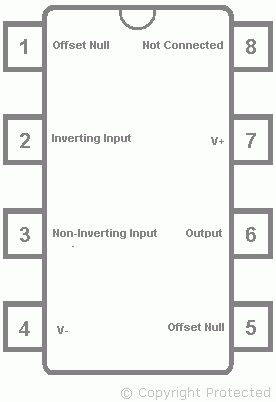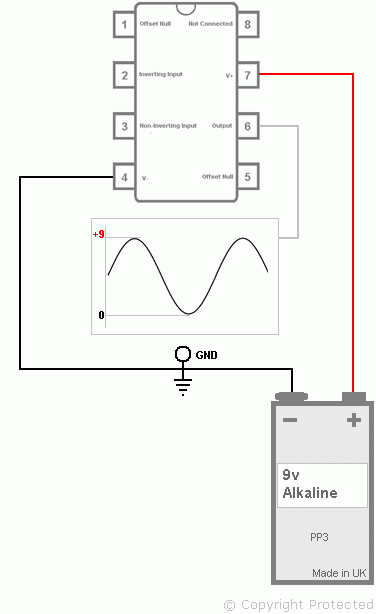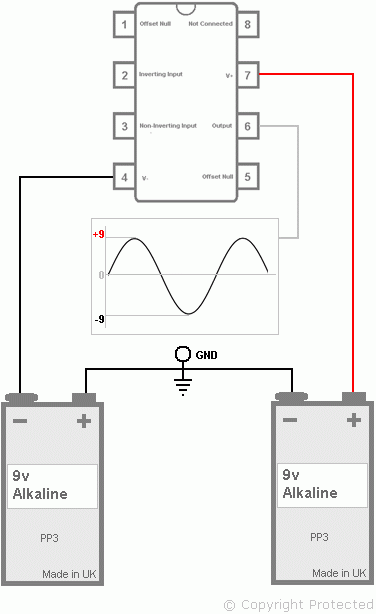741 Operational Amplifier
A 741 operational amplifier, also called op-amp, is a general-purpose voltage amplifier Integrated Circuit (IC). The IC is composed of direct-coupled (DC) transistor amplifier stages capable of providing a high-gain and wide frequency response range. A typical op-amp consists of a pair inverting and non-inverting inputs, and a single-ended output. First used in early analogue computers to perform mathematical operations, its name became operational amplifier as it could add, subtract, integrate, and differentiate.
Applications

Modern applications include audio amplifiers, buffers, dc amplifiers, oscillators, voltage regulators, high-pass filters, timers, comparators, and a host of other circuits.
This is a versatile component, and its applications are unlimited. A good engineer understands its characteristics so that he or she may apply them to new circuits.
Pinout

Op-amps can come in many packages with single, dual, and quad circuits. The single 8-pin PDIP is the most widely used by students.
As you can see from the pinout diagram, this is an 8-pin package, where pin 2 is the inverting input, pin 3 is the non-inverting input, and pin 6 is the single-ended output. For a single supply circuit, pin 4 connects to ground, and pin 7 to the positive rail.
Power Supply Voltage
The LM741 and LM741A operate at an absolute maximum voltage of ±22 V, whilst the LM741C at ±18 V.
Open Loop Gain
Open loop gain is an amplifier without a feedback loop. An ideal amplifier has an open loop gain of infinity; however, the value is typically in the magnitude of ×100,000 for DC signals in practice.
An amplifier is not stable with open loop gain due to the instability caused by thermal changes, circuit noise, age, and manufacturing imperfections. A feedback loop (closed loop gain) introduces stability, but at the cost of gain, by severely restricting it.
Unity Gain
Unity gain occurs with a closed loop gain. This is when the voltage follower circuit with the feedback loop is closed. Such circuits operate as buffers.
An Ideal Operational Amplifier
Input Impedance: An ideal amplifier has infinite input impedance so that the source remains unloaded by the current being drawn. Many 741 equivalent amplifiers have a FET input stage to help in this regard.
Output Impedance: an ideal amplifier has zero output impedance so that it may supply as much current is needed to drive the output load.
Gain: An ideal amplifier has infinite gain, but in practice, this is not possible.
Offset: The signal output must be zero when there is zero input between the inverting and non-inverting inputs.
Response Time: An ideal amplifier has zero response time; hence, a signal at the input instantaneously provides a signal at the output.
Single Supply

It is possible to use an operational amplifier with a single supply as shown in the circuit diagram above. In this configuration, pin 7 connects to the positive rail and pin 4 to the ground. In this configuration, the output signal would swing between ground and the positive rail.
Split-Rail Power Supply

It is very simple to make a split-rail power supply using two PP3 (9 V) dry cells as shown in the circuit diagram above. In this configuration, the output signal may swing between -9 V and +9 V rails.
Replacements
The LM741 op-amp is one of those wonderful classic general-purpose components, ideal for students and hobby professionals of all levels. The 8-pin PDIP comes in a manageable size that electronics enthusiasts of all levels can work with. There are many modern versions to the 741 that are pin compatible and identical in every respect. One such chip is the CA3140, which is an excellent replacement. My article on 741 Pin Compatible Equivalent Op Amps may help find cheaper equivalents.
Tips
When using op-amps it is always better to use an 8-pin plastic chip socket, which will make the circuit look professional and neat. This way you can then also reuse the same chip for different electronics projects, and save money!
The 741 op-amp comes in three different packages. The LM741H has the metal package, the LM741CN is the PDIP package, and the LM741W is the flat pack. Typically, students and beginners will want to use the PDIP package, as it will be easier to solder to standard prototyping boards
Equivalent to LM741
The LF411 is the electronic and pinout equivalent upgrade to the LM741. It has low offset, low drift and JFET Inputs providing high input impedance. Engineers can rapidly upgrade their circuits by replacing the old 741 for this new component that provides higher performance benefits.
This chip is high-speed with a high input impedance, high slew rate and wide bandwidth. Audio Technicians and hi-fi enthusiasts often upgrade to this chip to obtain better performance from their audio equipment. Ideally, you should also upgrade the capacitors as well for a better audio quality.
On-line Shop
Many different manufacturers such as National Semiconductors, STMicroelectronics, and Texas Instruments make the 741 op-amp chip. These chips generally have identical pinout and specifications, and the only difference is in the cost. Many online shops that advertise on this site provide the best deals.
Related Articles
741 Operational Amplifier741 Op Amp Gain Calculator
741 Op Amp Datasheet
Operational Amplifier GCSE